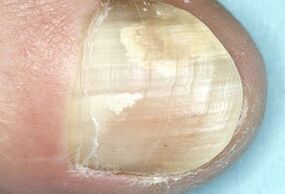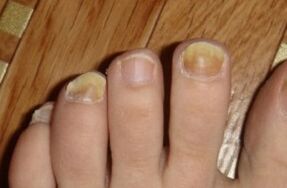
Nail plate fungus on the toes (onychomycosis) is an infectious disease that manifests as damage to the nails by dermatophytes, molds, or yeast-like fungi.According to statistics, the prevalence of this disease in the population reaches 10%.
The risk of contracting onychomycosis of the legs directly depends on the social and climatic conditions where a person lives, gender, age, occupation and the presence of other diseases.
Regardless, due to its high contagiousness and ability to significantly worsen patients' quality of daily life, this pathology requires prompt detection and effective, comprehensive treatment.
Symptoms of onychomycosis
Onychomycosis on the legs can be divided into three types based on symptoms:
- Hypertrophy;
- Normal nutrition;
- shriveled.
Hypertrophic nail lesions are characterized by significant thickening and deformation of the nail plate, loss of luster, and some kind of "erosion" at the edges.The clinical manifestations of the disease are complemented by the appearance of pain and the development of onychomycosis (a pathology in which the nails take on the appearance of a bird's claw).
With normal trophic onychomycosis, yellow or white streaks and spots appear on the nail plate.At the same time, the nails still maintain their shape, shine and thickness.In atrophic onychomycosis, the nail plate quickly separates from the nail bed and becomes dull and grey-brown.Exposed areas of skin are covered by a loose layer of hyperkeratosis.
The clinical symptoms of toenail fungus form the basis of an alternative classification of onychomycosis, used mainly by foreign doctors.Based on this type, 4 forms of the disease can be distinguished:
- distal (damage to the free edge of the nail);
- Proximal (posterior nail fold injury);
- Lateral (damage to the nail from the side);
- Total (entire deck damaged).
The severity of the symptoms of onychomycosis must be considered when formulating a treatment plan.
Toenail Fungus Treatment

The diagnosis of "onychomycosis of the legs" is made based on the results of visual medical examination, PCR testing, microscopic and culture studies.Carrying out the above-mentioned tests allows us to draw conclusions not only about the presence of a fungal infection, but also about the type of pathogen.
Now let’s talk about how to cure onychomycosis in the shortest possible time.Symptomatic treatment options for onychomycosis include the use of topical and systemic medications.The most effective topical treatments for toenail fungus are:
- Antifungal keratolysis ointments, gels and creams;
- Special plasters for mechanical removal of affected nails;
- Antifungal varnishes based on ciclopirox, amorolfine or a mixture of salicylic acid, benzoic acid, lactic acid and resorcinol.
Today, systemic treatment of onychomycosis seems to be the most relevant.In recent years, a variety of general antifungal drugs have been developed that can increase the effectiveness of the treatment of onychomycosis by up to 90%.
Drugs to treat onychomycosis
Varnish is considered the most effective antifungal varnish.The main feature of this product is its ability to destroy pathogens deep within the nail and penetrate the nail bed.Antifungal creams and ointments include products containing terbinafine.Apply the listed products to the affected nail plate daily and rub gently until completely absorbed.The duration of onychomycosis treatment with ointments and creams may range from 2-6 weeks.Procedures using topical antifungals should be approved in advance by a dermatologist.
The choice of systemic medication should take into account the severity of the disease and whether the patient has any contraindications to use.
Prevent onychomycosis
The main measures to prevent onychomycosis on the legs are:
- Avoid mechanical damage to the deck;
- Refuse to wear rough, tight and ill-fitting shoes;
- Carefully crafted pedicure tools;
- Wear separate shoes when going to the bathroom, sauna and swimming pool;
- Monitor the health status of pets and treat any symptoms promptly;
- This does not include the use of toiletries, clothing, towels and shoes belonging to others;
- detect and treat diseases promptly;
- Carry out activities designed to strengthen the body’s immunity.
It is important to understand that self-treatment of onychomycosis often not only fails to achieve the desired results, but also significantly complicates the course of the disease.Therefore, before using any medications or folk remedies to treat fungus, you should coordinate your treatment plan with an experienced dermatologist.























